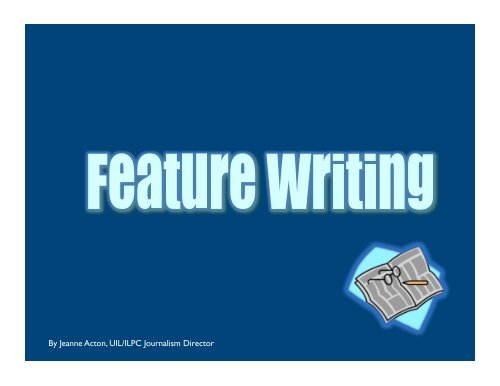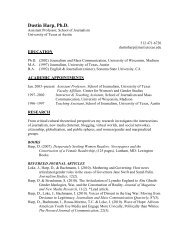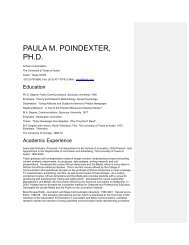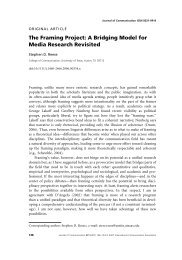Feature Writing - School of Journalism
Feature Writing - School of Journalism
Feature Writing - School of Journalism
- No tags were found...
Create successful ePaper yourself
Turn your PDF publications into a flip-book with our unique Google optimized e-Paper software.
By Jeanne Acton, UIL/ILPC <strong>Journalism</strong> Director
<strong>Feature</strong> <strong>Writing</strong> …tells the reader a story. It has abeginning (lead), middle and end.It uses quotes liberally and allowsthe reader to see the story throughdetailed description and vividwriting.
Transition/QuoteFormulaLinkedLead: Most interesting information.Something that will grab the reader’s attentionand drag them into the story.Nut Graph: A summary <strong>of</strong> what the storyis going to be about. Why the story isimportant.Direct Quote: Connects to the nut graph.Use more than one sentence. Direct quotesshould show the emotion <strong>of</strong> the story.Transition: Next important fact. Usetransition words to help the story flow. Theycan be facts, indirect quotes or partial quotes.LinkedDirect Quote: Connects to the firsttransition. Do not repeat the transition in thequote. DQ should elaborate on the transition.Transition: Next important fact. Usetransition words to help the story flow. Theycan be facts, indirect quotes or partial quotes.LinkedAnd so on … until the story is completeDirect Quote: Connects to the secondtransition. Do not repeat the transition in thequote. DQ should elaborate on the transition.
Let’s start at thebeginning with …LEADS
LeadsThe opening sentence must grab andhold the reader’s attention by usingspecific, interest-arousing words.
LeadsThe lead must catch the spirit <strong>of</strong> the storyand create the proper tone: serious,sarcastic, ironic, flippant, melancholy.
Leads Can be and <strong>of</strong>ten are longer than onesentence Your chance to grab the reader’sattention Should be specific to your story Should not be filled with cliches Should be in third person Must fit the mood or tone <strong>of</strong> the story
A Few Types <strong>of</strong> Leads Narrative - tells a story Descriptive - describes a scene, person orsubject Direct Quote – must be used with narrative Startling statement Contrast and Compare (then and now) Twist
Justin Greer’s 2,800 friends have never seenhim cry.His father has seen him cry only once — theday last October when doctors told the 16-year-oldfootball player that what he thought was a bad case <strong>of</strong>the flu was actually leukemia.“He cried a bit then,” Mr. Greer said. “But thenhe squared <strong>of</strong>f and said, ‘Well, I’m not dead yet.’ And Ihaven’t seen him cry since, although he’s told me thatsometimes he cries at night when he’s all alone.”
On senior Alicia Brigg’s two-hour trip with herparents to church, she turned around and noticed that inthe back <strong>of</strong> the Suburban all her bags were packed.“All <strong>of</strong> the sudden, I realized I wasn’t going tochurch; I was on my way to the airport,” she said. “Istarted screaming, crying and swearing at my dad,trying to figure out what was happening.”That’s when her dad told his 17-year-old daughterhe had put her up for adoption.
Descriptive - describes a scene/personIt is 7:30 Thursday night and the PresbyterianChurch <strong>of</strong> Utica is deserted except for its well-litcafeteria.Slowly they straggle in, single or in pairs. They are afriendly, yet haggard group, bearing the signs <strong>of</strong> a longemotional struggle.They are the parents <strong>of</strong> problem teenagers. There areno straight A honor roll students here. No footballcaptains or cheerleaders. Only drug addicts, alcoholicsand runaways.
DescriptiveIt’s too disturbing to watch the big screen TV at hiscousin’s house. Too soon. Too real.Instead, using his index fingers, Joshua Joseph twiddlesa Dove soap box, the one he used to scribble telephonenumbers on when he was evacuating.He flips the box around. There’s his girlfriend’snumber.Backward.His best friend’s digits.Forward.His coach’s number.This is Joseph’s cell phone now. His real one is lost,somewhere back in New Orleans along with most <strong>of</strong> hisclothes, his family’s house and life as he knew it.
Descriptive - describes a scene orpersonStanding in the lunch line, the boy turned to April Halerand asked, “Will you be my girlfriend?”Then he turned to his buddy and started laughing.Just another cruel joke on the fat kid.April, who once weighed almost 300 pounds, is used tothem. Since elementary school she has been teased andtaunted about her weight.“I remember being called horrible names in elementaryschool every time we went to the playground,” thesophomore said.But life is changing.
Descriptive - describes a scene or personSarah Clark knows what they think. The smirks. The laughs.The way the other girls, all week long in cheerleading practice,have been rolling their eyes.They think she’s a joke.They think she’s a big fat joke <strong>of</strong> an eighth grader with noprayer <strong>of</strong> becoming a high school cheerleader.Minutes before her tryout, Sarah paces the corridor. Shesweeps the waves <strong>of</strong> her long copper hair back over hershoulder. She tugs up on her socks and down on her cheerleaderskirt, pressed the night before.Then, with her eyes open and in the privacy <strong>of</strong> her mind, shemutters a prayer.Dear God, please …By 8 p.m. she’ll have her answer.
“Don’t be mad. I took some pills,” Karen Keatoncried as she stooped over the toilet.A few hours later, the 14-year-old freshman diedafter a series <strong>of</strong> coronary arrests.
“Coach Hawkins!”Brad Hawkins, the longtime Westlake athletictrainer, recognized Coach Steven Ramsey’s voiceover the noise <strong>of</strong> the spectators behind him. But hehad never heard Ramsey’s voice like that.Hawkins ran to Ramsey who was crouchedover varsity player Matt Nader pleading with theathlete.“Hang in there.”“Don’t leave us.”“Everything’s going to be all right.”
She never knew she had it.Junior Josh Duckworth has a fetish.
Melissa hates school.It’s not that she’s dumb. It isn’t that she doesn’tfit in socially. In fact, it isn’t that anything isparticularly wrong. It’s more <strong>of</strong> a matter <strong>of</strong> nothing being particularlyright.
A group <strong>of</strong> candystripers stand around the nursery, holdingincubator babies. It’s “loving time.” Another young girl steps in withher mother and picks up a baby, too. She is not in a uniform, but in ahospital gown, for the baby she holds is her own — and it’s her“loving time.”It’s also time to say good-bye.“I sat in that rocker and held him and rocked him and I criedand cried and cried,” Amber, a senior, said. “I wanted that moment tolast forever so I could always hold him and always be there for him.”“But I knew I couldn’t. That’s what hurt.”
How many children do you have?A simple question. Unassuming. Perfect for small talk.But Jim and Julie Silcock stumble.Dec. 29, 2002flashes in front <strong>of</strong> them. And they don’t knowwhat to do.Haltingly, Julie responds. We have one son named James. Heis a junior at Princeton.But the questions don’t end there. For the past six years, theynever have.
After tension-filled hours <strong>of</strong> last-minuteprimping, the time had come for the contestantsto walk into the arena and strut their stuff infront <strong>of</strong> the three judges and an appreciativecrowd.Some walked briskly with an air <strong>of</strong>confidence. Others, distracted by the lights andcameras, shuffled along slowly. A few, overcomeby the pressure, foamed at the mouth andmooed.
Even though Saturday’s market steercompetition at the Austin-Travis County LivestockShow and Rodeo was like many other beautypageants, there were some obvious differences.The contestants — steers weighing more thanhalf a ton — were being judged on the type <strong>of</strong> T-bones and rump roasts they would turn intoinstead <strong>of</strong> their appearance in an evening gown orbathing suit.
Oleg Mukhin wanted to see the world.His parents didn’t understand so he ran away.For two years, he’s lived in a hollow beneath theplatform at Moscow’s Vikhino railway station with otherrunaways.“Life’s not great, but I don’t want to go home,”said the 11-year-old.
<strong>Writing</strong> devices for leads Repetition (Melissa) Short, punchy sentences. Fragments. (Joshua) Using dialogue (adoption, Matt ) Mixing sentence length to set a rhythm (adopt, rodeo) Breaking the rules … starting with “And”
The lead should openwith the specific,then go to the general.
Rather than:With America engaged in a war in Iraq, manystudents know U.S. military men who have losttheir lives.Leaguetown lost one <strong>of</strong> its own last monthwhen Nicolas Barrera was killed in Iraq.
Try this:When Briana Barrera didn’t hear from her son,Nicolas, for a week she knew something waswrong. Maybe it was mother’s intuition, but sheknew.And when she saw two <strong>of</strong>ficers walking towardher door, her worst fear was confirmed.“The <strong>of</strong>ficers said they were sorry to deliver thenews, but Nicolas died with honor,” she said.“Dying with honor? How does that help? My heartwas breaking. My boy was gone.”
Lead writing pitfalls:• News or editorials leads. Avoidfirst and second person.• Stating the obvious.• Using cliches.• “Imagine this…” leads
No news or editorials leads.Avoid first and second personFreshman Sarah Clark made the cheerleadersquad for the 2007-08 school year.Congratulations to Sarah Clark for making thecheerleading squad. We are proud <strong>of</strong> her.
Don’t state the obviousEvery day, millions <strong>of</strong> people wake up, go towork or go to school. But some days, they don’t.Millions <strong>of</strong> teenagers have jobs. They workfor many reasons: college, cars, just to havesome spending money in their pocket.
No clichesTake one for the team.Life is short.And the winner is . . .
Do not “Imagine this…”Imagine what it would be like to sit througha hurricane. Dallas-resident Carly Patty doesn’t have to.She was stranded in Galveston duringHurricane Ike.Imagine what it would be like to get shot inthe face with a 57-automatic.Jeb Smith doesn’t have to imagine. He gotshot by his little brother by accident lastsummer.
Try this instead…He heard the shot and then felt the pain, but onlyfor a moment. Within seconds, junior Jeb Smithblacked out and went into shock. “I don’t remember much <strong>of</strong> the shooting,” hesaid. “I remember it felt like someone punched theirfist right through my face, but then I went black.”
What’s next?
After a strong lead…You need a strong nutgraph.
What is a nut graph?Basically, it is a summary <strong>of</strong> whatthe story is going to be about. It’sthe 5 Ws and H that you didn’tanswer in the lead.It’s the thesis sentence <strong>of</strong> yourstory.
The NutGraphHe heard the shot and then felt the pain, but onlyfor a moment. Within seconds, junior Jeb Smithblacked out and went into shock. “I don’t remember much <strong>of</strong> the shooting,” he said.“I remember it felt like someone punched their fistright through my face, but then I went black.”Last summer, Jeb’s five-year-old brotheraccidentally shot him in the face with his father’sloaded 57-magnum. Jeb lost his right eye and part <strong>of</strong>his right ear in the accident but suffered no permanentbrain damage. “I was extremely lucky,” Jeb said. “The doctor saidthe bullet missed my brain by an inch. I still have along way to go with my reconstructive surgery, but Iam just glad I am alive.”
What’s next?
After a strong lead and aninformative nut graph…Use the Transition/Quoteformula
He heard the shot and then felt the pain, but only for a moment.Within seconds, junior Jeb Smith blacked out and went intoshock. “I don’t remember much <strong>of</strong> the shooting,” he said. “Iremember it felt like someone punched their fist right through myface, but then I went black.”Last summer, Jeb’s five-year-old brother accidentally shot himin the face with his father’s loaded 57-magnum. Jeb lost his righteye and part <strong>of</strong> his right ear in the accident but suffered nopermanent brain damage. “I was extremely lucky,” Jeb said. “The doctor said the bulletmissed my brain by an inch. I still have a long way to go with myreconstructive surgery, but I am just glad I am alive.”
transitiondirect quotetransitiondirect quotetransitiondirect quoteJeb still needs four more surgeries, but none <strong>of</strong>them will help him regain his sight.“I am glad that they are going to make me lookmore like my old self,” Jeb said. “But I am upsetabout my eye. I wanted to be a pilot, and now thatdream is shattered.”Jeb said his little brother, Shane, found the gunin his father's dresser bureau on that summer day.“I think he was just curious,” Jeb said. “I didn’tthink the gun was loaded so I just told him to put itaway. And then, bam, my life changed forever.”Right after the gun went <strong>of</strong>f, Shane ran to theneighbor’s house to get help, Jeb said.“My little brother was scared, but he was alsosmart,” Jeb said. “He knew I needed help and heknew Lucy, our neighbor, was home. She came overand immediately called for an ambulance.”
So how do you enda feature story?
End your story with …- A powerful quoteOr- Tie the ending back to the lead
For example:(Lead)“Don’t be mad. I took some pills,” KarenKeaton cried as she stooped over the toilet.A few hours later, the 14-year-old freshmandied after a series <strong>of</strong> coronary arrests.(Ending) Since the death <strong>of</strong> her oldest daughter, theKeatons have found themselves becoming moreprotective. “I find myself watching for things,” Mrs.Keaton said. “I’m not sure for what. I’m justwatching.”
For example:(Lead)A group <strong>of</strong> candystripers stand around thenursery, holding incubator babies. It’s “loving time.”Another young girls steps in with her mother and picksup a baby, too. She is not in a uniform, but a in ahospital gown, for the baby she holds is her own — andit’s her “loving time.”It’s also time to say good-bye.“I sat in that rocker and held him and rockedhim and I cried and cried and cried,” Amber, a senior,said. “I wanted that moment to last forever so I couldalways hold him and always be there for him.“But I knew I couldn’t. That’s what hurt.”
(Ending) This was evident as she stated the one word thatdescribed the whole ordeal:“Pain,” she said, tears streaming down her cheeksand falling onto her sweater. “True pain.”
For a Strong <strong>Feature</strong> Story remember this …GQ STUDD
GQGreatQuotesSTUDDStrong LeadTransition/Quote FormulaUnique AngleDescription - Show Don’t TellDetail
Pitfalls to avoid infeature writing … Using a news lead <strong>Writing</strong> in the passive voice Messy handwriting Story doesn’t flow - doesn’t use T/Q formula Lack <strong>of</strong> strong quotes
On contest day … Read the entire prompt Take a moment. Remember whatstands out to you. Try to use that for yourlead. Reread the prompt and highlight orunderline powerful quotes. Also, mark your nut graph (usuallythe news peg) in the prompt. Cross out any unnecessary quotes orpeople. Write.







